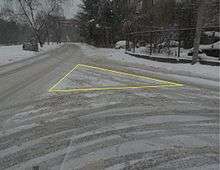Sneckdown
A sneckdown[1] or snowy neckdown[2] is effectively a curb extension caused by snowfall. A natural form of traffic calming, sneckdowns show where a street can potentially be narrowed to slow motor vehicle speeds and shorten pedestrian crossing distances. Coined by Streetsblog founder Aaron Naparstek,[3] popularized by Streetfilms director Clarence Eckerson, Jr. and spread widely via social media,[4] the term first appeared on Twitter on January 2, 2014 at 11:19pm EST.[5] Other Twitter hashtags that have been used to describe snow-based traffic-calming measures include #plowza, #slushdown, #snovered and #snowspace.

Benefits
- Shortens pedestrian crossing time
- Highlights unused road space
- Calms vehicle traffic
- Allows planners and road engineers to clearly see possible modifications to road structures
- Encourages slower vehicle speeds, increasing safety for all road users, including pedestrians
- Reduce asphalt surfaces, increase plant surfaces, improve the absorption of rainwater by the soil, reduce runoff and floods
Drawbacks
- Narrowing road also reduces time for driver to react when pedestrian steps on the road
- Large vehicles are wider than their tracks on snow, so pedestrian can be hit by vehicle mirrors, corners or outstanding parts of the vehicle body/trailer
- In case of a traffic collision narrow road is blocked
- On narrow road there is no way to yield to emergency vehicles as required by the rules
Examples
Philadelphia, Pennsylvania – Baltimore and 48th Street: A sneckdown inspired permanent upgrades to the pedestrian environment at this intersection in 2011.[6]
In the 1980s, some planners in Australia distributed cake flour in intersections to observe patterns of vehicle movement hours later.[7]
References
| Wikimedia Commons has media related to Sneckdowns. |
- "Streetfilms - Street Lessons from a Blizzard (with sneckdown!)".
- "Streetfilms - Snowy Neckdowns Redux: Winter Traffic Calming (Now: #sneckdown)".
- "Natural traffic control". The Economist. 13 February 2014.
- "Streetfilms - The Complete Origin of the #Sneckdown".
- "Aaron Naparstek". Twitter.
- "Can Snow Inspire Better Streets? It Already Has". Streetsblog USA.
- "Facebook".
External links
- Undriven Snow The Economist
- Sneckdown: Using Snow to Design Safer Streets BBC
- What the Heck is a Sneckdown? Treehugger
- 2014's Endless Snow Has at Least Been Good for Transportation Nerds Atlantic Cities
- "Sneckdowns" Reveal the Street Space Cars Don't Use Greater Greater Washington
- Sneckdowns: How snowstorms can teach us to build smarter roads The Week
- The 'sneckdown': Nature's pedestrian island WPIX11 News NYC